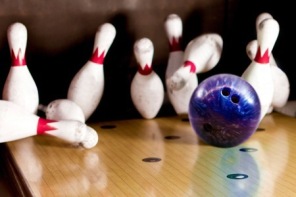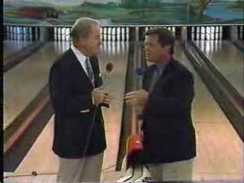King of the Palace, other Web shows strive to save the sport of candlepin bowling
It’s a Saturday morning in November, and Elizabeth Marquis and Ashley Bedard have brought their mothers to Mason’s Bowling Alley in Leominster, MA, for three strings of candlepin bowling. Just like every other Saturday morning, the quartet divide into two teams – daughters versus mothers – in what they call their own personal “bowling league.”
On the same Saturday morning, just 57 miles across the state at Riverwalk Lanes in Amesbury, MA, Jonathan Boudreau, 20, is bowling against Mark Ricci, 44, in the Classic Candlepins Season 1 Tournament of Champions to be broadcast on YouTube later in the month. Both bowlers are popular picks as two of the best candlepin bowlers in the US.
On the same Saturday morning, the 2015 Youth Candlepin Championship is taking place at the Bowlorama in Portsmouth, NH, featuring hundreds of youth bowlers separated into age divisions competing for plaques and money while creating lifetime memories.
The current landscape of New England’s proud tradition of candlepin bowling portrays a grand mixture of men, women, and children of any size, height, weight, and age who continue to play this 134-year-old game both casually and competitively.
Described by the International Candlepin Bowling Association as Northeastern America’s secret sport, candlepin bowling is often overshadowed by tenpin bowling, the sport with the three-holed bowling balls and hour-glass shaped pins that began appearing a few years after candlepin.
The differences between the variations of bowling can be counted on one hand – the ball size, the pin size, the balls rolled per box, the lob line, and the clearing of fallen pins.

- Candlepin Bowling (Source: Google Images)

Tenpin Bowling (Source: Google Images)
It shouldn’t make sense, then, that candlepin bowling is only popular in New England while tenpin has achieved nationwide success.
“I honestly feel that it isn’t nationwide because it is more difficult than tenpin,” said Dennis Nuzzo, a bowler from Saugus.
Gus Andries, 81, of New Brunswick, Canada, agreed. “Candlepin is a lot harder sport,” he said. “To a tenpin bowler, I would say try candlepin and see how good you are.”
However, in the late 1990s and early 2000s, a slew of candlepin television broadcasts were canceled either due to lessened interest or lack of money and sponsors. Most notably was Candlepin Bowling, a show that Don Gillis hosted from 1961-1996.
The show was taped on Tuesday mornings and broadcast on WHDH Channel 5 every Saturday morning. Bowlers would pay to qualify, and the top bowler in the qualifying round would bowl against last Saturday’s defending champion. At the end of the season, a tournament of champions would be televised live featuring the five champions with the top scores during the regular season.

1993 Candlpin Bowling championship show with Don Gillis and Ed Harding at Pilgrim Lanes in Haverill, MA (Source: YouTube.com/Wolfman12395)
“It showcased the sport’s highest level of bowlers, and showed how much fun and exciting the game is to play and to watch,” said Dave Chestercove, 31, president of the United States Candlepin Bowling Association.
“I wouldn’t leave the house until the show was over,” Nuzzo said.
In 1996, the candlepin community took a huge blow when the show was canceled and replaced due to the growing demand to broadcast Boston College football games.
The show, which lives on through viewable old episodes on YouTube, is still revered as a gem of the sport.
“The loss of the Candlepin Bowling show really killed the game,” said Nance Vestal, candlepin hall-of-famer from Lynn. “The drive to be great died with the show. There is nothing left for the above average bowler.”
According to Chestercove, candlepin’s downfall could be attributed to a lack of marketing.
“Candlepin bowling is a brand,” says Chestercove. “The loss of the old Channel 5 show was the brand’s primary marketing campaign. It had the highest payouts, which kept bowlers highly interested as well.”
A game played for fun has become a sport crippled by a vicious money cycle. Bowlers don’t want to bowl unless the cash payout is attractive. Daniel Finn, 28, of Franklin simplifies it as, “low payouts equals low turnouts, equals no sponsorships, equals no TV, equals lower payouts.”
Finn, who runs a kid’s bowling league at Ryan’s Amusement Center, says that the kids’ parents consider candlepin bowling practice for tenpin because “you can’t make a living on candlepin bowling.”
As a result, interest in bowling dropped in the 2000s. Bowling alleys were forced to raise prices to above $3 a game just to stay open.
“If the bowling alley in your home town closes, you don’t bowl,” Finn said. “You lose interest in the sport, which causes more alleys to shut down.”
“I have bowled in 136 different candlepin bowling alleys,” said Anthony Caron of Nashua, who has been bowling since 1979. “32 of those alleys no longer exist.”
“I remember having to wait for an alley,” said Dave Maattala, owner of New Palace Lanes in Fitchburg. “The 70s, 80s, and 90s is when you saw the peak. Bowling alleys would run 24 hours a day. People would wait for hours for an alley because it was the best enjoyment around.”
“Greed killed this sport,” said Nuzzo passionately. He explained that since Candlepin Bowling was taped on Tuesday mornings, only older viewers could be in the audience, thus creating a stigma that candlepin bowling didn’t appeal to the youth. Network executives, according to Nuzzo, wanted a younger viewership because they felt they couldn’t merchandize to older people.
Since the loss of Candlepin Bowling at the turn of the millennium, the landscape of candlepin bowling has changed. Today, candlepin bowling seems to be in a rebuilding phase.
There are bright movements, such as the Candlepin New Generation show hosted by Rob Taylor and Dan Gauthier that tapes the area’s best under-18 bowlers competing with partners and broadcasts on NESN.
However, if you search the NESN TV schedule online, Candlepin New Generation is nowhere to be found.
Web-based shows such as King of the Palace hosted by Dave Maattala, Classic Candlepins hosted by Mark Ricci, and New England

King of the Palace web show held at New Palace Lanes in Fitchburg, MA (Source: YouTube.com/NewPalaceLanes)
Candlepins Show hosted by Jay Horrigan are promoting the sport by uploading their own tournament matches to YouTube and local access television channels. Each show features adult bowlers competing for money, and like Candlepin Next Generation, the commentary and production is vastly different than Candlepin Bowling, giving the shows a fresh new feel.
In the case of King of the Palace, Nuzzo interviews the bowlers before and after the match. During the match, Maattala, Nuzzo and fellow commentator Steve Bronchuk are never afraid to crack a joke or venture off into discussion while there is a lull in the bowling action, providing entertainment when the bowling fails to do so.
Executive producer Travis Falk has become an expert with action replays, bloopers, and demonstrations of how the seemingly impossible is always possible in candlepin bowling. The show is known for its signature championship belt, similar to a WWE belt.
Perhaps most interesting is the interactive contests where YouTube viewers who email the show can guess match outcomes and win prizes.
Suddenly, the return of candlepin bowling on TV doesn’t seem so impossible.
According to Maattala, it all happened one morning when he was cleaning the basement where he found an old Channel 5 banner.
“I sat down and put pen to paper and decided that I was going to be the first in the new era to conduct a tournament that would air on TV and the Web, giving everyone a chance to showcase their skills and love for candlepin bowling,” Maattala said. “I wanted to be different, new, exciting, and I wanted to be an innovator.”
It almost didn’t work. Turnouts in the first season of the show were low, barely eclipsing 10 bowlers.
“I almost shut it down,” Maattala said. “I tried. I did what my vision was, and I was happy with what I had accomplished.”
But it was that point when King of the Palace became the perfect example of what the members of the proud candlepin bowling community have said countless times: Candlepin is not dead; it will thrive again.
And slowly but surely, they are proving to be right.
In the show’s second season, turnouts grew to over 35 bowlers. The 20-alley New Palace Lanes could barely fit two bowlers to a lane. Maattala knew he had to change things to re-invent the show, making it bigger and better to satisfy its growing audience.
Finding new sponsors made it possible to offer higher cash payouts. The championship belt was formed. Maattala described the show’s growing success as a “buzz that has not been around in a long time that started putting candlepin bowling back on the map.”
During the show’s third season, Fitchburg Access Television recognized Maattala, Nuzzo, Bronchuk, and Falk for on air personality. They all made it a mission to reach out to fans from all over the US and even countries like Canada, Sweden, and Switzerland that are supporting them now.
“I am humbled and truly touched by every fan out there,” Maattala said. “I respond to every single one and their response is that they did not think I would respond back.”
Other shows such as Classic Candlepins and New England Candlepins began to appear.
“I believe we are all competitive,” Maattala said. “But we are all supportive of what each show has to offer. We all do what we do for the love of the sport.”
For the older bowlers, the new web shows may not have the same grandeur of the old Channel 5 Candlepin Bowling show that they grew up with. But thanks to the collective efforts of pioneers like Maattala, Ricci, Taylor, and Horrigan, those fans finally have something to watch again.
For the younger generations of bowlers who were born after Candlepin Bowling was canceled, these web shows provide them with bowling they can learn from.
Most importantly, these web shows keep candlepin bowling alive. As they continue to grow in views, fans, and sponsorship money opportunities, the shows will expose the sport to the world.
More alleys will begin to appear across the nation. People will see it, and they’ll drive to their city’s alleys just to try it, like Marquis and Bedard did.
“We wanted to do something once a week where we could hang out but also be active,” Marquis said. “We’ve been doing it for over a year now. We’ve had so many laughs, we’ve made so many incredible memories, and we’ve become better bowlers!”
DJ Hosley















